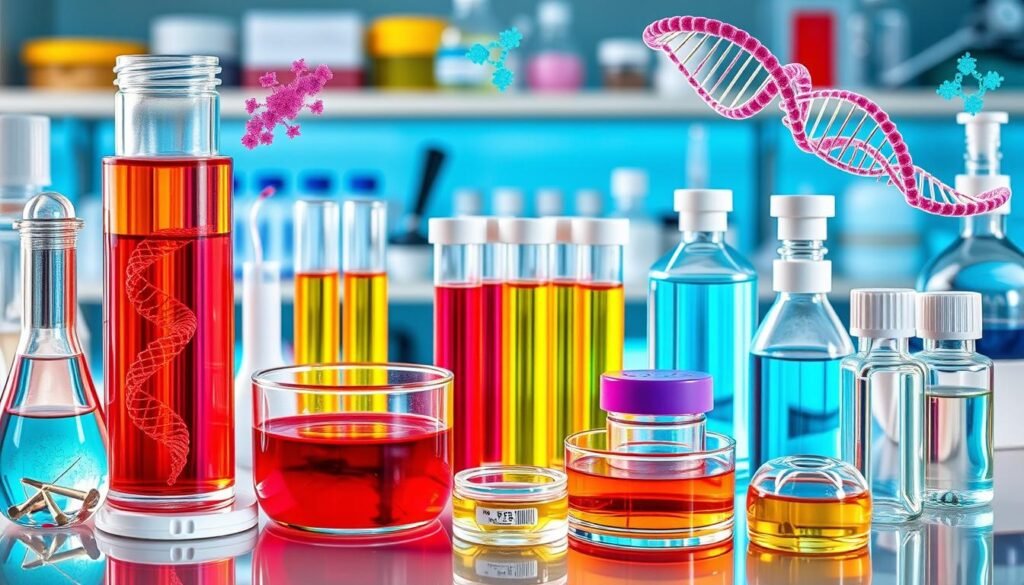Did you know? Over half of people with advanced lung cancer have a specific biomarker. These biomarkers are essential in figuring out the right treatment. Doctors now use biomarker testing to find these clues in lung cancer. It leads to better treatment plans that truly match each patient’s needs.
For those with a type of lung cancer called NSCLC, technology has changed everything. Now, doctors can plan treatments better. With the right tests, they can target the cancer more effectively. This means they can fight the cancer in a way that works best.
Key Takeaways
- Over 50% of advanced NSCLC patients have actionable biomarkers in their tumors.
- Biomarker testing directs personalized treatment plans for lung cancer patients.
- Early detection improves survival outcomes significantly.
- Comprehensive testing is recommended for all patients with advanced NSCLC.
- Liquid biopsy is a modern and FDA-approved method for lung cancer biomarker testing.
Introduction to Biomarker Testing
Biomarker testing is key in cancer care, especially for finding lung cancer biomarkers. It looks at DNA changes related to cancer. Understanding these changes improves how we treat cancer.
Finding biomarkers early is critical. It helps doctors choose the right therapies based on the genetic issues in the cancer. This approach can make treatments more effective and reduce side effects.
There are many types of biomarker tests, from simple to complex. For example, Guardant360 CDx and FoundationOne Liquid CDx show the progress in personalized medicine. They help pick the best therapy for each cancer, improving patient care.
Knowing about biomarker testing helps patients and families manage treatment better. It shows which therapies might work or not. Precision medicine is changing cancer care by focusing on biomarker testing.
| Type of Biomarker Testing | Examples | Purpose |
|---|---|---|
| Single Biomarker Tests | EGFR, ALK | Identify specific mutations to guide targeted therapies. |
| Multigene Tests | FoundationOne | Evaluate multiple genetic changes at once. |
| Whole-Exome Sequencing | N/A | Analyze all coding regions of genes in a tumor. |
| Liquid Biopsy Tests | Guardant360 CDx | Detect circulating tumor DNA in blood samples. |
What Are Lung Cancer Biomarkers?
Lung cancer biomarkers are key signs of the presence and severity of cancer. They reveal important details about the cancer, helping doctors create customized treatment plans. Learning about the types of biomarkers helps in diagnosing and treating lung cancer, improving patient outcomes.
Types of Lung Cancer Biomarkers
There are several types of biomarkers important in lung cancer. They fall into categories like:
- Gene mutations: Changes such as EGFR, KRAS, and ALK offer clues about the genetic factors of non-small cell lung cancer (NSCLC).
- Protein biomarkers: PD-L1 levels help decide if immunotherapy is a good choice for patients.
- Circulating tumor DNA: This marker, found in the blood, shows if the disease is getting worse or if treatments are working, helping to adjust therapies in time.
These biomarkers help confirm a lung cancer diagnosis and guide the choice of treatment for patients at different stages. For more details on blood-based biomarkers, read this comprehensive guide.
The Role of Biomarkers in Disease Progression
It’s vital to understand how lung cancer biomarkers affect disease progression. By monitoring these markers, healthcare providers can see how the cancer changes and decide on treatment changes. Precision medicine uses a person’s biomarker profile to improve therapy choices.
This method boosts the effectiveness of treatments and reduces unwanted side effects. As research on lung cancer biomarkers progresses, care for lung cancer patients becomes more tailored and effective.
Understanding Biomarker Testing and Its Role in Lung Cancer Diagnosis
Biomarker testing is key in improving lung cancer diagnosis and treatment plans. It checks for genetic changes and markers in the body. This helps doctors decide the best treatment for each patient. For those with non-small cell lung cancer (NSCLC), it’s critical to identify certain mutations like EGFR, ALK, and KRAS.
How Biomarker Testing Influences Treatment Options
Biomarker testing shapes treatment by uncovering the cancer’s genetics. If a patient has a mutation that responds to specific drugs, this info can guide the choice of treatment. This accuracy increases chances for success and reduces risks from unsuitable therapies.
Yet, about 50% of advanced-stage lung cancer patients don’t get full biomarker tests, even though they’re strongly advised. This gap underlines the importance of patients pushing for comprehensive testing. It’s crucial they talk to their doctors about getting tested without delay.
New biomarkers and techniques like liquid biopsies are changing lung cancer care. They offer valuable insights, even for early-stage patients, influencing treatment choices after surgery. The aim of biomarker testing is to provide care that’s tailored to each patient’s needs. This is especially vital for those who might not easily get access to these tests. For deeper insight, you can visit understanding biomarker testing in lung cancer.
The Importance of Early Detection in Lung Cancer
Finding lung cancer early is crucial for better patient outcomes. Studies show that early detection greatly increases successful treatment chances. If found early, treatments can work better, leading to higher survival rates and longer remission.
Statistics show the need for early diagnosis is urgent. Lung cancer is the top cancer killer in the US, with many deaths each year. Finding it early often leads to better survival rates. Late discovery, though, usually means a 5% survival rate after five years.
Tests for biological markers can help find lung cancer early. For example, serum biomarkers like CEA are quite effective in early detection. Detecting elevated CEA levels can indicate lung cancer before symptoms show.

Studies have found that cytologic atypia in sputum can indicate lung cancer 4-5 years before it fully develops. This kind of early detection can change a bad outlook to a hopeful one. It shows why increasing awareness and screening is critical.
| Staging | 5-Year Survival Rate | Clinical Features |
|---|---|---|
| Stage I | Approximately 75% | Localized, no lymph node involvement |
| Stage II | 40% – 60% | Possible lymph node involvement |
| Stage III | 25% – 40% | Involvement of nearby structures |
| Stage IV | 5% | Metastasis to distant organs |
In summary, early detection in lung cancer is key. The evidence for screening and biomarker tests is clear. These proactive steps can change patient outcomes drastically, bringing hope to those diagnosed.
Molecular Profiling: The Future of Lung Cancer Treatment
Molecular profiling is key in treating lung cancer. It lets doctors identify tumors by looking at their genes and molecules. This helps in figuring out the best way to tackle the cancer.
Understanding Targeted Therapy
Targeted therapy is a way to fight cancer more directly. It spots certain changes in cancer cells and attacks those changes. This leads to better results and fewer side effects. In particular, for non-small cell lung cancer (NSCLC), drugs like Sotorasib are effective for patients with specific gene changes, such as the KRAS mutation.
This discovery has changed how we treat lung cancer. It allows for treatments that match each person’s unique needs. Molecular profiling keeps shaping how we fight lung cancer, thanks to detailed information from targeted therapies.
Precision Medicine in Lung Cancer Care
Precision medicine tailors treatments to fit each cancer’s specific traits. This approach makes treatment more effective. Molecular profiling helps us understand the cancer better. It looks at mutations that affect how well treatments might work.
For example, testing for certain mutations is recommended right away for some types of lung cancer. This helps doctors choose the best treatment options early on. Highlighting personalized care, precision medicine improves how we manage and treat lung cancer. For more details, look at this treatment study.
| Molecular Alteration | Associated Targeted Therapy | Clinical Context |
|---|---|---|
| EGFR | EGFR Tyrosine Kinase Inhibitors | Effective in EGFR-mutant NSCLC |
| ALK | ALK Inhibitors | Used in ALK-positive NSCLC |
| KRASG12C | Sotorasib | For KRAS mutation patients |
| BRAFV600E | BRAF Inhibitors | Part of treatment involving BRAF alterations |
| MET exon-14 | MET Inhibitors | Targeted in MET-altered tumors |
Types of Biomarker Testing Methods
Biomarker testing methods offer key insights for lung cancer care. They fall into two categories: liquid biopsy and traditional biopsy. Each method has its own perks, helping doctors pick the best treatment for each patient.
Liquid Biopsy as a Modern Approach
A liquid biopsy checks for cancer DNA in the blood. It’s a simple method that tracks the cancer’s changes and reacts to treatments. Liquid biopsies can find certain mutations, pointing out markers like PD-L1. These markers guide the choice of treatment.
Traditional Biopsy Techniques
In a traditional biopsy, doctors remove tissue from the tumor. They use special techniques, like IHC staining, to look closer. This helps them see the PD-L1 marker levels in the cells. High PD-L1 levels could mean certain treatments are a good option. Though effective, traditional biopsies are more complex and have some risks.

| Biopsy Type | Invasiveness | Speed of Results | Ability to Monitor | Common Applications |
|---|---|---|---|---|
| Liquid Biopsy | Minimally invasive | Rapid | Real-time monitoring | Mutation detection, treatment evaluation |
| Traditional Biopsy | Invasive | Slower | Static evaluation | Tumor pathology, PD-L1 assessment |
Liquid biopsy and traditional biopsy are both crucial for precision medicine in lung cancer. By combining these methods, doctors can improve early detection and treatment results.
Insights on Driver Mutations Related to Lung Cancer
Driver mutations play a big role in non-small cell lung cancer (NSCLC). They are key to deciding the best treatment approaches. By focusing on these genetic changes, doctors can choose therapies that specifically target these mutations.
Common Driver Mutations in Non-Small Cell Lung Cancer
Many driver mutations affect NSCLC, changing how patients are treated and their outcomes. Important mutations include:
- EGFR: Mutation rates vary by population. Up to 60% of people in Western countries have changes that can be targeted. This number goes up to 80% among Asians.
- ALK: These mutations help in making targeted therapies. They can lead to resistance through different pathways.
- BRAF: Changes in this gene are linked to tumor growth. This knowledge helps in making customized treatments.
- KRAS: Found in resistant cases, KRAS mutations underline the challenges in treatment and the need for precise targeting.
A recent study showed the importance of detailed tests for finding these key mutations. This improves decision-making in clinical settings. Identifying driver mutations can greatly improve treatment outcomes for lung cancer. This personalizes patient care. As research continues, we might discover even better treatments for NSCLC.
Consulting with Experts: The Role of Healthcare Professionals
Talking to healthcare experts is key for the best lung cancer treatment. They use biomarker tests to make personalized treatment plans. This approach fits each patient’s specific needs.
More than 80% of patients get tested for certain biomarkers like EGFR and ALK. But testing for others like BRAF and KRAS is less common, under 60%. Experts are vital because they help patients understand the need for full testing.

Health experts know the latest treatment guidelines. Their knowledge helps patients get the best therapy options for their biomarkers. Seeing a specialist soon after diagnosis can make treatments work better. This helps patients manage lung cancer most effectively.
It’s important to make comprehensive biomarker testing easier for everyone. Healthcare workers, support groups, and policy leaders are working together. They want to make these thorough tests standard for all patients.
The healthcare field for lung cancer is always changing. Doctors and nurses play a huge role in guiding patients through these changes. They make sure patients get the care they need. This includes joining clinical trials and getting treatments meant just for them. It’s all about improving patients’ lives.
Patient Experiences: The Impact of Biomarker Testing
Patient experiences with biomarker testing are key in lung cancer treatment. Since 2020, LUNGevity’s research has shown how people deal with the complexities of biomarker testing. There’s a big need for teaching patients about test methods and results. This has led to tools like the 4R Care Sequence® for Care Initiation, which helps make diagnosing and choosing treatments easier.
Real-Life Cases and Success Stories
Success stories from biomarker testing show its huge impact. A patient with ROS1-positive lung cancer began targeted therapy and saw his cancer almost gone in six weeks. He felt his life quality skyrocket after starting treatment. His story shows how biomarker testing can provide custom care and push for raising awareness in less served areas. It also stresses teaching about biomarker testing’s benefits.
Considerations for Patients and Caregivers
Though biomarker testing has successes, there are important things for patients and caregivers to think about. Focus group talks shed light on different experiences with healthcare provider conversations. Many said that test reports were hard to understand. They needed simpler words and better formats. Caregivers must help make test results clear, explaining terms and what they mean. Using educational resources from groups like LUNGevity can help understand lung cancer treatment paths better.
Conclusion
Biomarker testing has changed how we detect and treat lung cancer. It gives deep details on a tumor’s makeup. This lets doctors make treatment plans that match each patient’s unique cancer genetics. As test technology gets better, we’ll know more about lung cancer genes. This could lead to better results for patients.
This testing doesn’t just help pick treatments; it also checks how well they’re working. It can find if a drug stops working soon enough to change the plan. Plus, since most health insurers cover it, many patients can get these important tests. This makes personalized treatment more available.
The more we use biomarker testing, the better we can focus on each patient’s needs. This means the future of lung cancer care looks promising. These tests are key in crafting the best treatment plans, especially before surgery. The move towards targeted lung cancer management is really just starting.